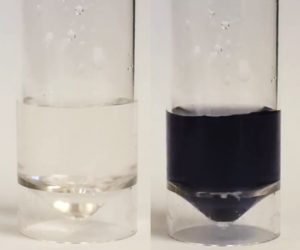
Clock reactions are amongst the most dramatic and visually pleasing chemical demonstrations.
Typically after a clock reaction has been started there is a period during which no noticeable change takes place and then a change (often in colour) occurs. This sudden and unexpected nature of the change gives clock reactions their charm and visual appeal.
The activity described here is an alternative to the iodine clock reaction.
Oxidation of iodide by iron III ions in an acidic medium is a reaction that can easily be transformed into a clock reaction. Thiosulphate is used as a limiting reagent and starch as an indicator for I3− ions.
From J Chem Ed Vol 85 No8 Aug 2008 p1123 Kinetics and Mechanism of Iodide Oxidation by Iron(III): A Clock Reaction Approach – Jurica Bauer and Vladislav Tomišic´



